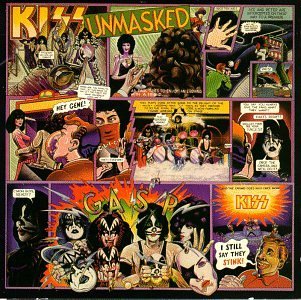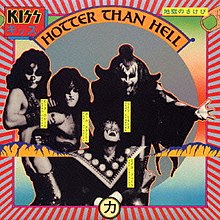
Kiss was an American rock band formed in New York City in 1973 by Paul Stanley, Gene Simmons, Ace Frehley, and Peter Criss. Known for their face paint and stage outfits, the group rose to prominence in the mid-1970s with shock rock-style live performances which featured fire-breathing, blood-spitting, smoking guitars, shooting rockets, levitating drum kits, and pyrotechnics. The band had gone through several lineup changes, with Stanley and Simmons remaining the only consistent members. The final lineup consisted of them, Tommy Thayer, and Eric Singer.

Paul Daniel "Ace" Frehley is an American musician who was the original lead guitarist, occasional lead vocalist and founding member of the rock band Kiss. He invented the persona of The Spaceman and played with the group from its inception in 1973 until his departure in 1982. After leaving Kiss, Frehley formed his own band named Frehley's Comet and released two albums with the group. He subsequently embarked on a solo career, which was put on hold when he rejoined Kiss in 1996 for a highly successful reunion tour.

Destroyer is the fourth studio album by American hard rock band Kiss, released on March 15, 1976, by Casablanca Records in the US. It was the third successive Kiss album to reach the top 40 in the US, as well as the first to chart in Germany and New Zealand. The album was certified gold by the RIAA on April 22, 1976, and platinum on November 11 of the same year, the first Kiss album to achieve platinum. The album marked a departure from the raw sound of the band's first three albums.

Unmasked is the eighth studio album by American hard rock band Kiss, released on May 20, 1980, by Casablanca Records. It was their first not to feature original drummer and founding member Peter Criss. Despite having no involvement in its production, Criss features in the album's artwork and the video for "Shandi", and also receives credit.

Dressed to Kill is the third studio album by American hard rock band Kiss, released on March 19, 1975. It was produced by Casablanca Records president Neil Bogart and the band itself as the label's financial situation at the time did not permit the hiring of a professional producer.

Kiss is the debut studio album by American rock band Kiss, released on February 18, 1974. Much of the material on the album was written by Gene Simmons and Paul Stanley, as members of their pre-Kiss band Wicked Lester. Simmons estimated that the entire process of recording and mixing took three weeks, while co-producer Richie Wise has stated it took just 13 days.

Rock and Roll Over is the fifth studio album by American rock band Kiss, released in 1976. It was recorded at the Star Theatre in Nanuet, New York.

Love Gun is the sixth studio album by American hard rock band Kiss, released on June 30, 1977. Casablanca Records and FilmWorks shipped one million copies of the album on this date. It was certified platinum and became the band's first top 5 album on the Billboard 200. The album was remastered in 1997 and again in 2014.

Alive II is the second live album by American hard rock band Kiss, released on October 14, 1977, by Casablanca Records. The band had released three albums since the previous live outing, the 1975 release Alive!, so they drew upon the variety of new tracks, with Eddie Kramer producing. The album is one of the best selling in the Kiss discography, being the band's first to be certified double platinum in February 1996, the same month the Kiss reunion tour was announced. It has continued to sell in the US in the Soundscan era, selling over 300,000 copies from 1991 and to March 2012.

Ace Frehley is the first solo album by American guitarist and former Kiss member Ace Frehley, released on September 18, 1978, by Casablanca Records. It was one of four albums released by each separate Kiss member as a solo act, but yet still under the Kiss label, coming out alongside Peter Criss, Paul Stanley, and Gene Simmons.

Peter Criss is the first solo album by Peter Criss, the drummer of American hard rock band Kiss. It was one of four solo albums released by the members of Kiss on September 18, 1978, but yet under the Kiss label, coming out alongside Ace Frehley, Gene Simmons and Paul Stanley. The album was produced by Vini Poncia, who went on to produce Dynasty (1979) and Unmasked (1980) for Kiss.

Paul Stanley is the first solo album from American musician Paul Stanley, the singer-songwriter best known for serving as the rhythm guitarist and lead vocalist of hard rock band Kiss. It was one of four solo albums released by the members of Kiss on September 18, 1978, yet still under the Kiss label, and coming out alongside Peter Criss, Ace Frehley, and Gene Simmons. It is the only release out of the four Kiss solo albums to feature all original songs, as Simmons, Criss and Frehley each recorded one cover song on their albums.

Dynasty is the seventh studio album by American rock band Kiss, produced by Vini Poncia and released on May 23, 1979, by Casablanca Records.

Music from "The Elder" is the ninth studio album by American rock band Kiss, released on the Casablanca Records label in 1981. The album marked a substantial departure from their previous output with the concept and orchestral elements. Music from "The Elder" was the first album with the drummer Eric Carr and the last album to feature guitarist Ace Frehley until their 1996 reunion.

Creatures of the Night is the tenth studio album by American rock band Kiss, released in 1982. It was the band's last for Casablanca Records, the only label for which Kiss had recorded up to that point. The album was dedicated to the memory of Casablanca founder and early Kiss supporter Neil Bogart, who had died of cancer during the recording sessions. It is also the band's last album recorded with Ace Frehley credited as an official member and their first album with Vinnie Vincent, as the initially uncredited lead guitarist. Vincent would later be credited but not featured on the cover of the 1985 reissue of the album. It was also Kiss' last album to feature the band with their trademark makeup until the release of Psycho Circus in 1998.

"Beth" is a song by American rock band Kiss, originally released on their 1976 album Destroyer. The song features drummer Peter Criss on lead vocals, and while he's gotten credit for writing it because he brought the demo to Kiss, "Beth" was written primarily by Stan Penridge and producer Bob Ezrin. Casablanca Records released it as a single in August 1976, after it was released as the B-side of "Detroit Rock City". "Beth" is Kiss's biggest commercial hit in the United States; it reached #7 on the Billboard Hot 100, received a Gold Record certification from the RIAA, and won the 1977 People's Choice Award for "Favorite Song". In 2003, "Beth" ranked #3 in VH1's 25 Greatest Power Ballads.

"Rock and Roll All Nite" is a song by American rock band Kiss, originally released on their 1975 album Dressed to Kill. It was released as the A-side of their fifth single, with the album track "Getaway". The studio version of the song peaked at No. 69 on the Billboard singles chart, besting the band's previous charting single, "Kissin' Time" (#89). A subsequent live version, released as a single in October 1975, eventually reached No. 12 in early 1976, the first of six Top 20 songs for Kiss in the 1970s. "Rock and Roll All Nite" became Kiss's signature song and has served as the group's closing concert number in almost every concert since 1976. In 2008, it was named the 16th greatest hard rock song of all time by VH1.

Alive! is the fourth album overall, and the first live album, by American hard rock band Kiss, released on September 10, 1975. It is considered to be their breakthrough, and a landmark for live albums. The double-album contains live versions of selected tracks from their first three studio albums, Kiss, Hotter Than Hell and Dressed to Kill. It was recorded at concerts in Detroit, Michigan; Cleveland, Ohio; Wildwood, New Jersey; and Davenport, Iowa on May 16, June 21, July 20 and 23, 1975.
"Parasite" is a song by American hard rock band Kiss, released in 1974 on their second studio album, Hotter Than Hell. The song is one of three songs featured on the album written by lead guitarist Ace Frehley. As one of the album's heaviest songs, "Parasite" was performed on the following tour, but Kiss dropped it from the setlist for the Destroyer Tour and did not play it again until the Revenge Tour in 1992. As Frehley was insecure about his singing ability, he passed that duty to Gene Simmons. In 2016, Frehley re-recorded the track with John 5 for Frehley's solo album Origins Vol. 1.
"Let Me Go, Rock 'n' Roll" is a song by the American hard rock band Kiss, released in 1974. It was released as the only single from their second album Hotter Than Hell. Even though the song failed to chart, it is a staple in their live concerts. The B-side was the album title track, "Hotter Than Hell". Gene Simmons penned the lyrics during a lunch break at his day job, and the song conveys romantic excitement: "'Cause baby's got the feeling/Baby wants a show/Baby won't you tell me/Baby rock & roll, yeah, yeah!". "Let Me Go, Rock 'n' Roll" became a live favorite for Kiss.


















